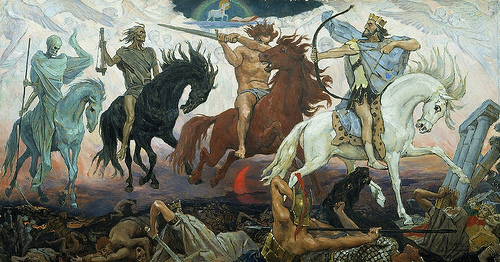We run our website the way we wished the whole internet worked: we provide high quality original content with no ads. We are funded solely by your direct support. Please consider supporting this project.

Unpacking Revelation: Is it Literal?
According to many scholars as well as many Christian laypeople, the Jesus we find in the book of Revelation engages in a great deal of violence. This violence reaches a zenith in chapter 19 where we find Jesus going out to make war on a white horse (v. 11). He is dressed in a blood stained robe (v. 13) and has a sword coming out of his mouth “to strike down the nations” while he “treads the winepress of the fury of the wrath of God Almighty” (v. 15). Jesus and his army fight “the beast and the kings of the earth and their armies” (v. 19). They capture the beast and the false prophet and throw them “alive into the fiery lake of burning sulfur,” and they slay “[t]he rest… with the sword” (v. 21). This delightful account ends with the observation that “all the birds gorged themselves on their flesh” (v. 21).
If we accept the popular view that Revelation is a literal prophecy of end-time events, then we obviously must qualify, if not completely abandon, the claim that Jesus revealed an altogether non-violent God. In this series of posts, however, I will defend the view, espoused by a wide array of NT scholars, that this interpretation is fundamentally mistaken. Indeed, this interpretation misses the most fundamental point of this book.
To start off I will begin with four observations about why the popular literal interpretation of Revelation is not viable.
First, most scholars agree that Revelation’s basic framework is apocalyptic. So, as is common among apocalyptic works, Revelation purports to let its audience in on a divine secret by offering them a heavenly perspective of earthly events. More specifically, Revelation reveals a theological interpretation of events that its audience is “soon” going to experience (1:1; 22:6). Hence, though John uses end-of-the-world imagery, as you’d expect from an apocalyptic type of work, the close proximity of the events Revelation is speaking about should rule out interpreting Revelation as though it was describing the end of world. Moreover, the very fact that it shares so much with the apocalyptic genre, which trades heavily in symbolism, should make us very hesitant to interpret anything it describes literally.
Second, interpreting Revelation’s symbolism as referring to literal end-time events produces a multitude of contradictions and absurdities. To offer one trivial but clear example, when I first read Revelation as a new 17-year-old Christian in a fundamentalist church, I was troubled by John’s statement that all the stars fell from the sky “to the earth, like figs” (6:13). Since I had been taught that this work provides a literal depiction of future events, the cosmological absurdity of this passage bothered me. And my disquietude only intensified when I discovered two chapters later John reporting that the stars were back up in the sky (8:12) only to have a third of them swept away once again four chapters later (12:4)! Revelation is filled with word-pictures such as these that are absurd if interpreted literally but that are altogether unproblematic and deeply insightful when interpreted symbolically.
Third, it is important to understand that Revelation, like the Gospels, was written as an oral performance. This much is reflected in the book’s opening pronouncement: “Blessed is the one who reads aloud the words of this prophecy, and blessed are those who hear it…” (1:3, emphasis added). We must therefore understand Revelation along the lines of a dramatic performance. Hence, careful attention must be paid not only to the theological significance of Revelation’s dramatic symbols, but also to how these symbols were intended to impact hearers. Revelation is a poetic book that aims to influence and even persuade the churches to respond.
This again means that John is not attempting to provide his audience with esoteric information about how world history is going to wrap up. He is rather employing imaginative symbols to alter his audience’s understanding of their world as a means of motivating them to respond to it in certain way. More specifically, he is using graphic symbolism to motivate his audience to resist the ways of “Babylon” – John’s symbol for Rome and all the kingdoms of the world that are under Satan’s deception – and to do so even if it means that they will be martyred.
And fourth, while a casual reading of Revelation gives the impression that it is reporting a series of spontaneous visions, it is important we understand that this book has actually been composed with great skill. Some scholars argue that this is one of the greatest literary works of the NT. One scholar argues that “scarcely a word” in this book “can have been chosen without deliberate reflection on its relationship to the work as an integrated, interconnected whole.”[1] The most important implication of this observation is that it means that we must pay close attention to details and patterns as we interpret this work.
When we see that Revelation is so much more than a literal prediction of end times, we will discover that John has subtly, and brilliantly, subverted, and even reversed, the violence that he seems to ascribe to Jesus. We will explore this over the next few posts.
[1] Bauckham, Climax, x. So argues Eller, ibid., 213-4.
Photo credit: Waiting For The Word via VisualHunt.com / CC BY
Category: General
Tags: Bible Interpretation, Book of Revelation, Jesus, Violence
Topics: Biblical Interpretation, End Times
Related Reading

Is Islam Inherently Violent?
An increasing number of people, especially in conservative Christian circles, are claiming that Islam is an inherently violent religion. They point to all the violence in the history of Islam and all of the violence being carried out by Muslims today as proof of this. I believe this claim is as misguided as it is…

What did Jesus mean when he said he came not to bring peace, but a sword (Mt 10:34)?
Given Jesus’ uniform teaching about loving enemies and abstaining from violence, and given that his followers were known for their refusal to engage in violence for the first three hundred years of church history, it’s obvious that Jesus wasn’t saying he came so that his disciples would use swords. The context of Jesus’ comment makes…

How Are We To Love the Soldiers of ISIS?
Over the last several weeks I’ve received some form of this question almost every day. In some cases the question is asked rhetorically, as though the very question exposes the absurdity of suggesting we are to love this terroristic group. Other times the question is asked with a pragmatic twist. One person recently said to…

Is God Immutable? Part I
For a number of reasons, Plato believed that something changes only to become better or to become worse (Rep. II). Since a perfect being can’t be improved or diminished, he argued, God must be completely unchanging, As this idea was developed over time, Plato’s followers concluded that not only must God’s character be unchanging, but…

The Philando Castile Verdict
I’m not going to get political. I’m just going to be honest. My heart is pounding. In anger. In sorrow. In fear (over what this might lead to). I know that, unlike the jury, we don’t have all the facts. Got that. But I honestly wonder, what on earth could Philando Castile have done differently…

The Cruciform Center Part 4: How Revelation Reveals a Cruciform God
I’ve been arguing that, while everything Jesus did and taught revealed God, the character of the God he reveals is most perfectly expressed by his loving sacrifice on the cross. Our theology and our reading of Scripture should therefore not merely be “Christocentric”: it should be “crucicentric.” My claim, which I will attempt to demonstrate…
